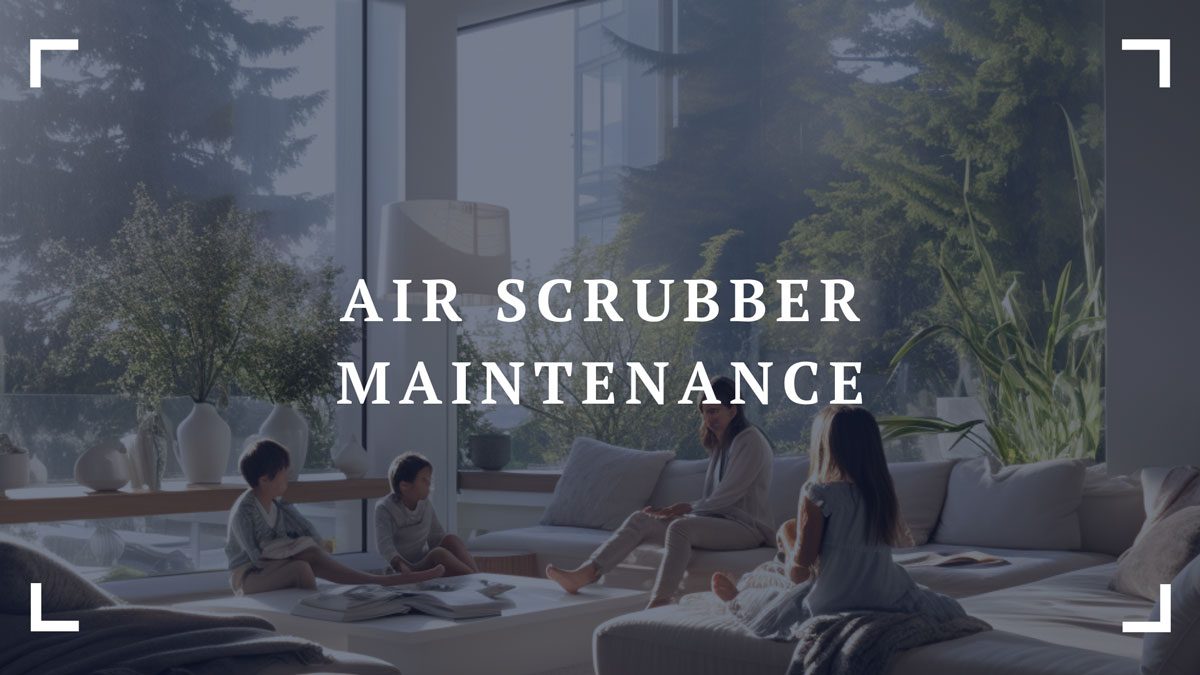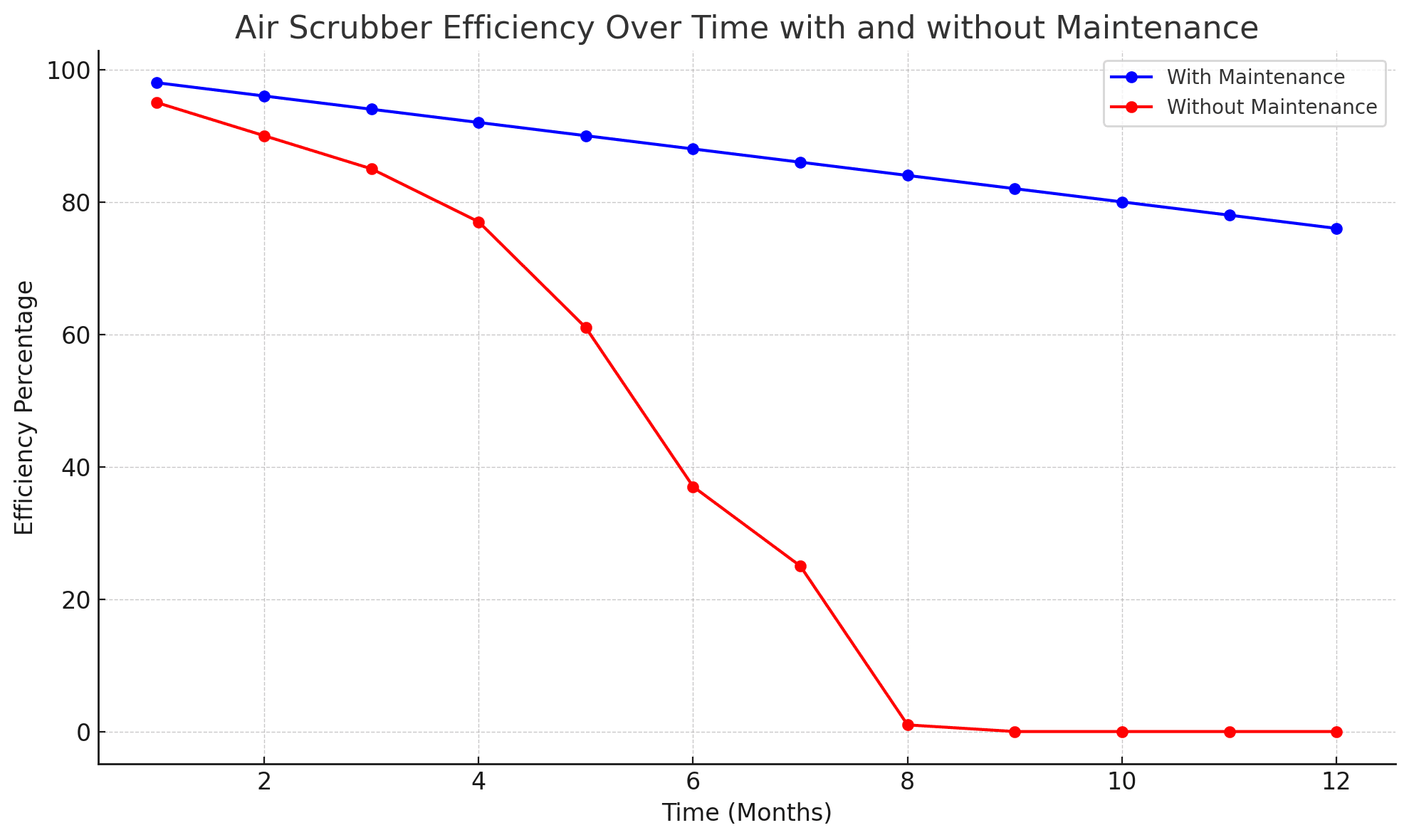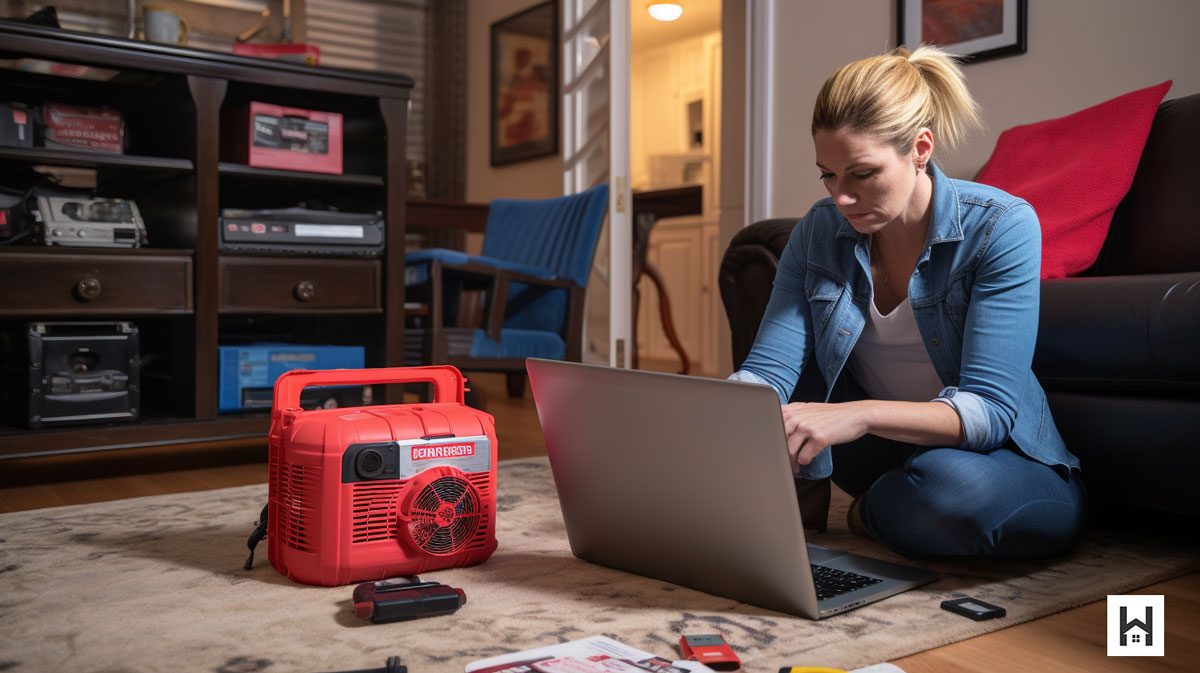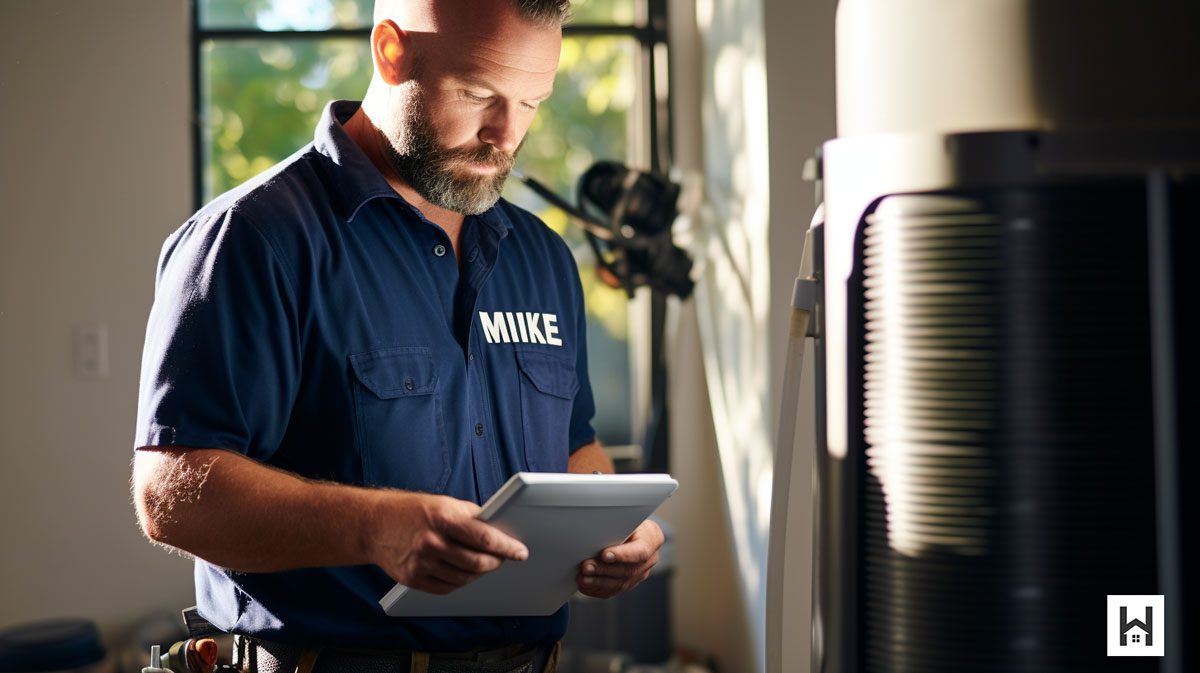Imagine taking a deep breath, expecting fresh air, but instead, you’re met with a musty odor or the sneeze-triggering presence of dust. Now, imagine a world where every breath you take indoors feels like a mountain’s fresh breeze. That’s the promise of a well-maintained air scrubber. But, like all promises, it requires effort to keep. Dive into this comprehensive guide, and discover not just how to maintain your air scrubber, but why it’s an urgent necessity in today’s world.
Key Takeaways
Clean air is essential for our health and well-being. Air scrubbers play a pivotal role in ensuring the air we breathe indoors is free from pollutants and contaminants.
Regular maintenance, both DIY and professional, ensures that your air scrubber operates at peak efficiency, extends its lifespan, and prevents costly repairs.
Brad Smith emphasizes the importance of air quality in modern living and the future of interior design. He also highlights common mistakes in air scrubber maintenance and the significance of professional check-ups.
A well-maintained air scrubber not only ensures clean air but also contributes to a reduced carbon footprint and energy consumption.
Table of Contents
- Key Takeaways
- Understanding Air Scrubbers
- The Significance of Regular Maintenance
- Step-by-Step Guide to Air Scrubber Maintenance
- Advanced Maintenance Tips
- Common Issues and Troubleshooting
- The Environmental Impact
- Expert Insights: Brad Smith’s Personal Experience
- The Importance of Professional Maintenance
- Conclusion
- FAQ

Understanding Air Scrubbers
What is an Air Scrubber?
An air scrubber is a device that removes particles, gases, and even chemicals from the air within a building. Think of it as a supercharged air purifier. While it sounds technical, at its core, an air scrubber is all about giving you the best air quality possible. Want a deeper dive into the nitty-gritty of air scrubbers? Check out this article I wrote on what an air scrubber is and how it works.
How Do Air Scrubbers Work?
Air scrubbers use a combination of filters and sometimes even UV light to clean the air. As air flows into the scrubber, particles get trapped in the filters, while gases and odors are broken down. If there’s a UV component, it’s there to kill off bacteria and viruses. It’s like a spa day, but for the air in your home!
The Difference Between Air Scrubbers and Air Purifiers
Now, you might be thinking, “Brad, isn’t that just an air purifier?” Well, not quite. While both devices aim to clean the air, air scrubbers are typically more powerful and are used in settings where air quality is crucial, like hospitals or labs. Air purifiers are great for everyday use, but if you’re dealing with serious contaminants or mold issues (speaking of mold, here’s a list of the best air scrubbers for mold remediation), you’ll want an air scrubber on your side.
The Significance of Regular Maintenance

Alright, let’s get into the heart of the matter. You’ve got this fantastic air scrubber working its magic in your home, but like all good things, it needs a bit of love and care to keep doing its job well. Here’s why regular maintenance is a game-changer:
Ensuring Optimal Performance
Imagine running a marathon with a backpack full of bricks. Sounds exhausting, right? That’s how your air scrubber feels when it’s clogged or not maintained. Regular check-ups ensure it’s working at peak performance, giving you the cleanest air possible.
Extending the Lifespan of Your Device
We all want our gadgets to last, and air scrubbers are no exception. Think of maintenance as a spa day for your device. It refreshes and rejuvenates, ensuring you get the most bang for your buck in the long run.
Preventing Costly Repairs and Replacements
A stitch in time saves nine, they say. Addressing minor issues before they become major problems can save you a pretty penny. Plus, who wants the hassle of a broken device when you can avoid it with a bit of TLC?
Step-by-Step Guide to Air Scrubber Maintenance
| Task | Frequency | DIY or Professional | Notes |
|---|---|---|---|
| Filter Replacement/Cleaning | Every 3-6 months | DIY | More frequent in high-pollution areas |
| Electrical Components Inspection | Annually | Professional | Ensure no wear or damage |
| UV Light Check | Every 6 months | DIY | Replace if dim or non-functional |
| Sensor Calibration | Annually | Professional | For accurate readings |
| Seasonal Preparation | Bi-annually | DIY | Different settings for summer & winter |
Okay, now that we’ve established the ‘why,’ let’s tackle the ‘how.’ Maintaining your air scrubber might sound daunting, but I promise, with this guide, it’ll be a breeze.
Regular Cleaning: The Key to Efficiency
- Frequency: Aim to give your air scrubber a general clean every month.
- Method: Use a damp cloth to wipe down the exterior. For the interior, refer to your device’s manual (each model can be a tad different).
- Pro Tip: Always unplug your device before cleaning. Safety first!
Checking and Replacing Filters
- Frequency: Check filters every 2-3 months. Depending on usage and air quality, you might need to replace them every 6-12 months.
- Method: Slide out the filter and inspect for dirt, clogs, or damage. If it’s beyond cleaning, it’s time for a replacement.
- Pro Tip: Always have a spare filter on hand. You never know when you’ll need it!
Inspecting the Electrical Components
- Frequency: Once a year or if you notice any irregularities in performance.
- Method: This is a bit technical, so if you’re unsure, it might be best to call in a professional. If you’re feeling adventurous, ensure the device is unplugged, open it up, and check for any loose wires or signs of wear.
- Pro Tip: If you smell burning or hear unusual noises, turn off the device immediately and consult a professional.
Monitoring Airflow and Ensuring Unobstructed Vents
- Frequency: Every couple of months.
- Method: Check the vents for any blockages or dust build-up. Ensure the device is placed in an area with good airflow and isn’t obstructed by furniture or curtains.
- Pro Tip: A well-ventilated area not only helps the device work better but also ensures the clean air is distributed evenly throughout the room.
Advanced Maintenance Tips

So, you’ve got the basics down and your air scrubber is purring like a kitten. But for those of you who, like me, love to go the extra mile, here are some advanced maintenance tips to supercharge your device’s performance.
The Role of UV Lights in Air Scrubbers
UV lights are like the secret sauce in some air scrubbers. They’re designed to kill bacteria, viruses, and other microorganisms that might escape the filters.
- Frequency: Check the UV light every 6 months.
- Method: Ensure the light is shining bright and clear. If it’s dim or flickering, it might be time for a replacement.
- Pro Tip: While UV lights are fantastic for killing germs, they don’t replace the need for regular filter changes. Think of them as the dynamic duo of clean air!
Calibrating Sensors for Accurate Readings
Modern air scrubbers come with sensors that detect air quality in real-time. But like all sensors, they can drift over time.
- Frequency: Calibrate sensors once a year.
- Method: Most devices will have a calibration function built-in. Refer to your manual for step-by-step instructions. If you’re unsure, it might be best to call in a technician.
- Pro Tip: Keep the area around the air scrubber free from strong odors or chemicals when calibrating. You want the most accurate reading possible.
Seasonal Maintenance: Preparing for Winter and Summer
Just like you swap out your wardrobe for the changing seasons, your air scrubber needs a bit of prep too.
- Winter Prep:
- Check the seals and insulation. Cold air can affect performance.
- Ensure the device is away from heaters or radiators. Excessive heat can damage internal components.
- Summer Prep:
- If your device has a humidifier function, ensure it’s clean and ready for the drier months.
- Place the device in a cool, shaded area. Overheating can reduce efficiency.
- Pro Tip: Seasonal maintenance is also a great time to give your device a thorough clean and check for any wear and tear.
Common Issues and Troubleshooting

Alright, let’s face it. Even the best of gadgets can throw a tantrum every now and then. But don’t fret! I’m here to guide you through some common issues with air scrubbers and how to troubleshoot them. Let’s roll up our sleeves and dive in!
Recognizing Early Signs of Malfunction
Being proactive can save you a lot of headaches down the road. Here’s what to keep an eye out for:
- Unusual Noises: If your air scrubber starts sounding like a rock band, it’s a sign something’s amiss.
- Odd Smells: A burning or chemical smell is a definite red flag.
- Reduced Airflow: If the breeze from your device feels more like a whisper, it’s time to investigate.
- Pro Tip: Trust your senses. If something feels off, it probably is. Better safe than sorry!
Addressing Reduced Airflow and Efficiency
This is a common issue, but with a bit of detective work, you can get to the root of the problem.
- Check the Filters: A clogged filter is often the culprit. Give it a clean or replace if necessary.
- Inspect the Vents: Ensure they’re free from obstructions and dust build-up.
- Positioning: Make sure your device isn’t tucked away in a corner. It needs space to breathe and work efficiently.
- Pro Tip: Regular maintenance, as we discussed earlier, can prevent most airflow issues. A stitch in time saves nine!
What to Do When Your Air Scrubber Isn’t Turning On
It’s the heart-stopping moment we all dread. But don’t panic just yet. Here’s a checklist to troubleshoot the issue:
- Power Source: Ensure the device is plugged in and the socket is functional. Sometimes, it’s as simple as a tripped breaker.
- Check the Cord: Look for any signs of damage or wear.
- Inspect the On/Off Switch: It might sound silly, but sometimes switches can malfunction.
- Internal Fuse: Some devices have an internal fuse that can blow. Refer to your manual on how to check and replace it.
- Pro Tip: If you’ve tried all the above and your device still isn’t turning on, it’s time to call in the professionals. It might be an internal issue that needs expert attention.
Remember, while troubleshooting can fix many issues, always prioritize safety. If you’re unsure about something, it’s best to consult a professional. Your air scrubber is a vital part of your home, and with a bit of care, it’ll serve you well for years to come.
The Environmental Impact

In our journey to breathe cleaner air indoors, it’s essential not to forget the bigger picture: our planet. The environmental impact of our choices, even those related to air scrubbers, is significant. Let’s explore how these devices, when used responsibly, can be a boon for Mother Earth.
How Well-maintained Air Scrubbers Benefit the Environment
Maintaining your air scrubber isn’t just good for your health and wallet; it’s a win for the environment too. Here’s how:
- Reduced Waste: A well-maintained air scrubber lasts longer, meaning fewer devices end up in landfills.
- Efficient Operation: A clean and efficient air scrubber doesn’t have to work as hard, reducing energy consumption.
- Better Air Quality: By effectively removing pollutants, air scrubbers reduce the need for other, potentially more harmful, methods of air purification.
- Pro Tip: Think of your air scrubber as a mini environmental warrior. Every bit of care you give it translates to a healthier planet.
Reducing Energy Consumption and Carbon Footprint
Every device in our homes contributes to our overall energy consumption. But with a few mindful practices, we can minimize our carbon footprint:
- Regular Maintenance: As we’ve discussed, a clean air scrubber operates more efficiently, using less energy.
- Optimal Placement: Positioning your device in a well-ventilated area means it doesn’t have to work overtime.
- Use Only When Needed: While it’s tempting to have the air scrubber on 24/7, turning it off when not needed can save a significant amount of energy.
- Upgrade to Energy-Efficient Models: If you’re in the market for a new air scrubber, consider models that are designed to be energy efficient.
- Pro Tip: Small changes can have a big impact. By being mindful of our energy consumption, we can play our part in reducing our carbon footprint and paving the way for a greener future.
Our homes are our sanctuaries, and while we strive for comfort and health, it’s crucial to remember our responsibility to the planet. By making informed choices and practicing regular maintenance, we can enjoy the benefits of clean air without compromising the health of our environment.
Expert Insights: Brad Smith’s Personal Experience
Brad Smith, the CEO and Lead Interior Designer at OmniHomeIdeas.com, isn’t just an expert in the field; he’s also a passionate advocate for clean air and sustainable living. Drawing from his vast experience, Brad shares some invaluable insights into the world of air scrubbers, their maintenance, and the future of air quality in interior design.
Common Mistakes in Air Scrubber Maintenance
Having seen countless homes and worked with numerous clients, Brad has identified some common pitfalls that homeowners often fall into:
- Neglecting Regular Checks: “Many believe that once installed, air scrubbers are set-and-forget devices. This couldn’t be further from the truth. Regular checks are crucial.”
- Using Generic or Incompatible Filters: “Not all filters are created equal. Using the wrong type can severely hamper your device’s efficiency.”
- Ignoring Manufacturer Guidelines: “Always refer to the manual. It’s there for a reason and provides a wealth of information tailored to your specific model.”
- Pro Tip from Brad: “Think of your air scrubber as a prized plant. It needs regular care, the right environment, and a bit of attention to truly flourish.”
The Future of Air Quality and Interior Design
Brad believes that the future of interior design is intrinsically linked to air quality. Here are some of his predictions and insights:
- Integrated Air Quality Systems: “The homes of the future will have air quality systems seamlessly integrated into their design. Think hidden vents, smart sensors, and automated controls.”
- Sustainability as a Priority: “With the growing awareness of environmental issues, sustainable materials and energy-efficient designs will be at the forefront.”
- Holistic Health Approach: “It’s not just about aesthetics anymore. The focus will shift to creating spaces that nurture both physical and mental well-being. Clean air plays a pivotal role in this.”
- Pro Tip from Brad: “For those renovating or building new homes, consider investing in designs and systems that prioritize air quality. It’s a game-changer, not just for your health but also for the planet.”
Brad’s insights serve as a timely reminder of the evolving landscape of interior design and the pivotal role air quality plays in it. As we move towards a future where health, sustainability, and design converge, the humble air scrubber, with its promise of clean air, stands as a testament to innovation and foresight.
The Importance of Professional Maintenance

While DIY maintenance can go a long way, there are times when the expertise of a professional is indispensable. Let’s delve into why professional maintenance is crucial and how it can make a world of difference to your air scrubber’s performance and lifespan.
When to Call in the Experts
There are certain signs and situations where it’s best to let the professionals take over:
- Complex Repairs: If your air scrubber is showing signs of significant wear or malfunction, it’s time to call in the experts.
- Routine Check-ups: Just like your car needs an occasional professional tune-up, so does your air scrubber.
- Upgrades and Replacements: If you’re considering upgrading your system or replacing parts, a professional can provide valuable advice and ensure proper installation.
- Pro Tip: Don’t wait for a complete breakdown. Regular professional check-ups can identify and rectify potential issues before they escalate.
Benefits of Regular Professional Check-ups
Investing in professional maintenance comes with a slew of benefits:
- Extended Lifespan: Professionals can spot and rectify issues that might otherwise shorten your device’s life.
- Optimal Performance: Ensure your air scrubber operates at peak efficiency.
- Cost Savings: Preventative maintenance can save you from costly repairs or replacements in the long run.
- Peace of Mind: There’s a certain comfort in knowing that your device has been looked over by a professional and is in top-notch condition.
Conclusion
In our fast-paced, modern world, the importance of clean air cannot be overstated. Air scrubbers, with their promise of purer, healthier air, have become an integral part of our homes. They not only protect our health but also enhance our overall quality of life.
Brad Smith, our expert from OmniHomeIdeas.com, sums it up perfectly: “Air quality isn’t a luxury; it’s a necessity. As we continue to make strides in interior design and home comfort, let’s not forget the air we breathe. Invest in an air scrubber, maintain it well, and breathe easy.”
FAQ
Are there any signs that my air scrubber is not working as efficiently as it should?
Yes, some common signs include a noticeable decrease in air quality, unusual noises from the device, a persistent musty or burnt odor, and increased allergy symptoms among residents. If you notice any of these signs, it’s a good idea to check the device and consider professional maintenance.
How often should I replace the filters in my air scrubber?
While it largely depends on the manufacturer’s recommendations and the specific model, a general rule of thumb is to replace or clean filters every 3-6 months. However, if you live in an area with high pollution or have pets, you might need to do it more frequently.
Can I use my air scrubber in conjunction with other air purification devices?
Absolutely! Many homeowners use air scrubbers alongside air purifiers, humidifiers, or dehumidifiers to create an optimal indoor air environment. Just ensure that all devices are well-maintained and compatible with one another.
Is there a best time of day to run my air scrubber for maximum efficiency?
Air scrubbers are designed to run efficiently at any time of day. However, if you’re looking to optimize energy consumption, consider running it during off-peak hours or when the indoor air quality is at its lowest, such as after cooking or cleaning.
Are air scrubbers safe for homes with children and pets?
Yes, air scrubbers are safe for all members of the household, including children and pets. In fact, they can be especially beneficial for those with respiratory issues or allergies. Just ensure that the device is placed in a location where it won’t be accidentally knocked over or tampered with.


